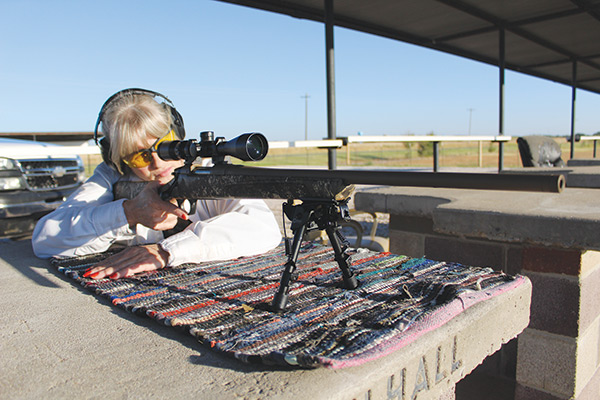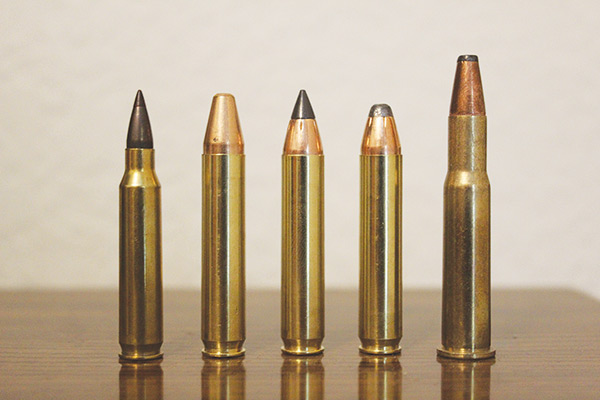 Guns & Ammo: .350 Legend for Savage 110 Hogs
Guns & Ammo: .350 Legend for Savage 110 Hogs
By Randy Smith

When the .350 Legend came out, frankly, it seemed to me like another over hyped wonder with rather ho-hum ballistics. I don’t just jump on the bandwagon when a new cartridge comes along. I tend to stick with proven rounds such as the .243 or .30-06. For years, my only big-game rifle was a lever-action .30-30.
My interest in the round began the day after I brought home a gelding colt.
He was adopted from BLM land and wild as a deer. A week later, I wound up in the hospital for six weeks of recovery from an emergency procedure. With several other horses and that colt to worry about, I needed someone to monitor my farm and horses.
A friend who had experience with horses volunteered to care for my livestock while I was laid up. Not only did Tiff do a first-rate job watching the stock, she had the colt literally eating out of her hand and thoroughly gentled by the time I was back on my feet. She wouldn’t take any pay, and I owed her.
Tiff occasionally came out to the farm to do some target shooting with her .22 rifle and 9mm handgun. She was competent with both, and when she mentioned that she had never hunted deer but had always wanted to, the light bulb went off. Not only would I set her up for a first deer hunt on my place, I would buy her a new deer rifle. I believe that owning your own rifle enhances the commitment to and enjoyment of hunting.
Picking a firearm for someone else is always tricky, and I am usually reluctant to do so. But I wanted to surprise her, and if she knew before I made the purchase, she might object that I was being too generous.
Tiff had already told me she had no experience with big-game rifles and I’d seen other small-framed women totally put off when someone placed a rifle in their hands that had too long a length of pull and too much recoil. I am always mindful of the recoil when handing anyone a handgun, rifle, or shotgun to shoot for the first time.
I am not comfortable with a .223 for deer. The recoil is mild enough, and in expert hands it may be fine, but there isn’t much margin for error when it comes to shot placement. I decided to go with a .243 or a .30-30 carbine because that level of recoil is generally tolerable for most folks. A shot from my blind would probably be no more than 150 yards.
This was at the peak of the pandemic, and the shelves were bare of most hunting rounds. I could not find .30-30 or .243 anywhere I looked, yet Butch Foster had a whole stack of .350 Legend boxes in his gun shop. In fact, several places I looked had plenty of reasonably priced .350 Legend. By then I had read some encouraging reports and also heard first-hand accounts of hunting success with the .350 Legend, so I did a little homework.
The straight-walled cartridge places a .357 projectile in an expanded .223 case design. It was introduced in 2019 by Winchester specifically for states that allow straight-wall rifle cartridges for deer but not the use of tapered cartridges that tend to have more range. The smallest diameter bullet allowed by some straight-wall states is .357.
The .350 Legend has superior energy to a .30-30 with less recoil. Velocity in factory hunting loads runs around 2,100 feet a second, and the 180-grain bullet retains about 900 foot-pounds of energy at 200 yards.
My first thought was that I’d get her a Mossberg Patriot in .350 Legend. The synthetic stock Patriot is light, rugged, compact, and has an excellent trigger. We have a long family history with Mossberg firearms, and I’ve enjoyed excellent relations with the company. No matter where I looked, however, I couldn’t find a .350 Legend Patriot.
I had about given up and was thinking about which of my rifles to loan Tiff when I strolled past the gun counter at our local Walmart and noticed several new rifles in the case. I asked the attendant if any .350 Legend rifles had come in.
“Just one,” he replied. “And it’s a CVA Cascade.”
Having had excellent experiences with a .243 CVA Cascade, I asked to see it. He handed me a camouflage-stocked package rifle with a Konus 3-9X40 scope already mounted. The Cascade has easily removable stock inserts to reduce length of pull for small-framed shooters, and the trigger felt very good. I started filling out the government paperwork.
The shortened stock fit Tiff fine, but the 22-inch barrel was too front heavy for her to support comfortably off-hand. Putting cross-sticks under the rifle fixed that. She managed the recoil and muzzle blast very well wearing hearing protection.
As already stated, Tiff was a good shot with her .22 rifle so I reasoned that familiarizing her with the more potent centerfire and then building her self-confidence were my main goals. I started her at 25 yards and then moved her out to 50 yards, shooting no more than five rounds at a time. Why so close? Success builds confidence.
After a couple of sessions, she was printing inch groups at those ranges. Next, I set up a deer silhouette target at 70 yards. It only took one practice session for her to shoot the same size groups in the target’s red heart image. I am a meat hunter and prefer heart shots over shoulder hits. I would never advise a beginning hunter to try a neck or head shot.
I placed a black target dot on the heart and told her to concentrate on just that dot. The groups tightened even more, and I told her to note where that dot was located on the deer’s body. We discussed deer anatomy and why a broadside shot would be most effective.
The deer blind at my place is the size of an outhouse. There isn’t room for two, so after I showed her how to open and close the windows and safely manage the rifle in tight quarters, she would be on her own. I told her that as long as she kept calm and concentrated on shot placement, she would be just fine.
Thanksgiving evening, I let her off at the blind and parked my truck on a hilltop 200 yards away where I could watch the area with binoculars and hope for the best. When the neighbors began a holiday target practice session, I did not expect anything would come in. But I decided we’d tough it out until dark. Tiff told me later that she was thinking the same thing.
The neighbors finally packed it in, and just as the sun began to set, a young eight-point buck came to the feeder. I hoped Tiff would take it, and after several minutes, the rifle barked. She told me later that she was waiting for the buck to move to a proper angle and take a nearside step forward so she had a clear heart shot. The buck jumped a low fence before rolling head over heels in the love grass.
When we opened the buck’s chest, blood gushed from the cavity. The bullet had split the heart. There was literally no meat damage. In fact, we harvested enough from that young buck to put 80 pounds of burger in Tiff’s freezer.
First time in the stand and a nice eight-point in the sights doesn’t happen very often. No doubt she had been lucky, but she had certainly done her part. I have seen the same thing with other young and beginning hunters. If they are given patient instruction and have confidence in their shooting, they get it done.
Tiff was a huge fan of the .350 Legend after that. Later, shooting off a bipod at a formal shooting range, she shot some impressive 100- and 120-yard groups with the Cascade. I decided I’d like to try the round myself.
Almost a year later, I came across a Savage 110 Hog Hunter chambered in .350 Legend. I have been impressed with the new line of Savage rifles since the company changed ownership. The competitively priced Savage Axis is extremely popular in my area. Yet I still prefer the older style 110 and thought the 110 Hog Hunter was especially well-configured.
Anyone can call a rifle anything they want, but I felt that real thought and hunting experience had gone into labeling this one Hog Hunter.
Feral hogs in my area are most often found in well-watered, heavily timbered cover. Daytime hunting is usually done at modest range over bait or from a location overlooking water, especially in warm weather. Another option is stalking the thickets hoping to find hogs bedded during the day. Shots are usually very quick at short range, often at running hogs.
Open sights mounted on a compact fast-handling rifle work very well. The good old .30-30 carbine shines, and while the 110 Hog Hunter is not a lever gun, it is a compact bolt-action with an 18-inch barrel and a set of excellent iron sights. It also has Savage’s signature AccuTrigger, an oversized bolt handle, and the length of pull is easily adjustable. A detachable four-round magazine fits flush with the stock. As with all Savage rifles, out-of-the-box hunting accuracy is guaranteed.
It comes drilled and tapped for a scope, but I was quite comfortable with the open sights. In fact, I prefer them in many hunting situations. I have plenty of scoped rifles to fill other duties. The only change I made was the addition of a flash hider to the already threaded muzzle.
We are planning a Texas hog hunt this fall, and I’ll also be packing my new rifle in the hog lairs and creek bottoms closer to home come winter. Perhaps I’ll hunt whitetails with it, too.
Whether you are setting up someone for a first deer hunt or simply want a low-recoiling and accurate mid-range hunting rifle for yourself, I recommend checking out the .350 Legend.
Several gunmakers chamber relatively inexpensive, compact and rugged bolt-action rifles. Equally rugged and even less costly single shots are also made. If your taste runs toward the AR, these are also readily available in .350 Legend. The cartridge has a lot to offer.
